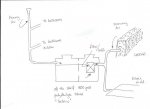Hi and thx all - read the other thread and my queries are more venting/chemical

New septic tank (single unit 1000 galls taking all household waste) and has been running from new for a family of 3 for about 6 weeks, and all seems pretty good - waste in, 'water' out soak away etc. etc.
No additives or starter packs, just us and the water in the tank.
The system has two vents 100mm (4") and air can pass freely from one end of system to other.
- one on the arrival side which not only which brings all the goodness to the tank but also vents freely to fresh air right up high at roof level,
- and the other (on the exit side) temporarily is hidden in a garden hedge......could stay there, doesn't give any trouble.
The roof level vent has been giving off some really good strong odours, which by nature of the house can be smelt inside (via open windows) and in a raised garden close by.
(This vent/down pipe, total H about 9m, is inside the house and thus heated, so i'm guessing natural convection will tend to draw smelly air from septic tank up and out?)
So first question is can I put a one way air 'valve' on this vent so air can be drawn into system towards tank, but no smell released? I guess i can, but what may be side effects? (other than the hedge vent venting)
Do happy septic tanks smell big time? and always?
Have to say our tank seems to be mellowing in a good way, and the vicious cheesy (as in cheese cheese) odours seems to be lessening.......about right?
So for a long and happy relationship with one's septic tank what are the frequent/occasional tasks to be undertaken?
I've read about monitoring pH, and yoghurt treats!
Any help much appreciated




